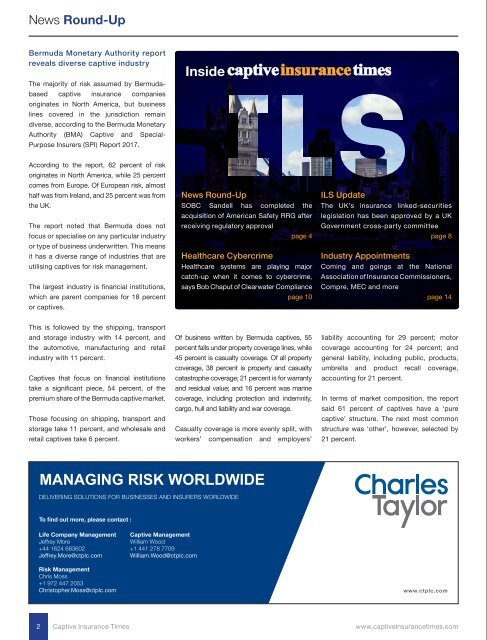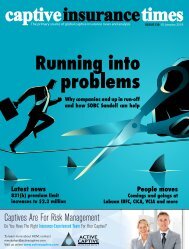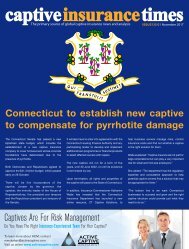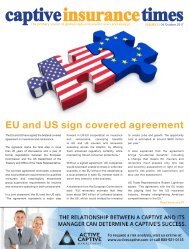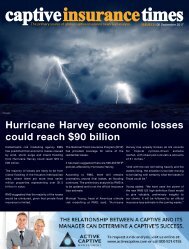Captive Insurance Times issue 138
In this issue of Captive Insurance Times, find out more on the UK’s insurance linked-securities (ILS) legislation, which was passed on 29 November. After two years in the making, a government cross-party committee approved the UK’s Risk Transformation Regulations 2017 and the Risk Transformation (Tax) Regulations 2017, which make up the UK’s ILS legislation. In other news, Bob Chaput of Clearwater Compliance discusses how healthcare systems are playing major catch-up when it comes to cybercrime. From everyone at Captive Insurance Times, we wish all of our readers a very Merry Christmas and a happy and prosperous New Year. Don't forget to visit www.captiveinsurancetimes.com to read the latest news, scan the most recent issues, or check out upcoming events.
In this issue of Captive Insurance Times, find out more on the UK’s insurance linked-securities (ILS) legislation, which was passed on 29 November.
After two years in the making, a government cross-party committee approved the UK’s Risk Transformation Regulations 2017 and the Risk Transformation (Tax) Regulations 2017, which make up the UK’s ILS legislation.
In other news, Bob Chaput of Clearwater Compliance discusses how healthcare systems are playing major catch-up when it comes to cybercrime.
From everyone at Captive Insurance Times, we wish all of our readers a very Merry Christmas and a happy and prosperous New Year.
Don't forget to visit www.captiveinsurancetimes.com to read the latest news, scan the most recent issues, or check out upcoming events.
Create successful ePaper yourself
Turn your PDF publications into a flip-book with our unique Google optimized e-Paper software.
News Round-Up<br />
Bermuda Monetary Authority report<br />
reveals diverse captive industry<br />
The majority of risk assumed by Bermudabased<br />
captive insurance companies<br />
originates in North America, but business<br />
lines covered in the jurisdiction remain<br />
diverse, according to the Bermuda Monetary<br />
Authority (BMA) <strong>Captive</strong> and Special-<br />
Purpose Insurers (SPI) Report 2017.<br />
Inside<br />
According to the report, 62 percent of risk<br />
originates in North America, while 25 percent<br />
comes from Europe. Of European risk, almost<br />
half was from Ireland, and 25 percent was from<br />
the UK.<br />
The report noted that Bermuda does not<br />
focus or specialise on any particular industry<br />
or type of business underwritten. This means<br />
it has a diverse range of industries that are<br />
utilising captives for risk management.<br />
The largest industry is financial institutions,<br />
which are parent companies for 18 percent<br />
or captives.<br />
News Round-Up<br />
SOBC Sandell has completed the<br />
acquisition of American Safety RRG after<br />
receiving regulatory approval<br />
page 4<br />
Healthcare Cybercrime<br />
Healthcare systems are playing major<br />
catch-up when it comes to cybercrime,<br />
says Bob Chaput of Clearwater Compliance<br />
page 10<br />
ILS Update<br />
The UK’s insurance linked-securities<br />
legislation has been approved by a UK<br />
Government cross-party committee<br />
page 8<br />
Industry Appointments<br />
Coming and goings at the National<br />
Association of <strong>Insurance</strong> Commissioners,<br />
Compre, MEC and more<br />
page 14<br />
This is followed by the shipping, transport<br />
and storage industry with 14 percent, and<br />
the automotive, manufacturing and retail<br />
industry with 11 percent.<br />
<strong>Captive</strong>s that focus on financial institutions<br />
take a significant piece, 54 percent, of the<br />
premium share of the Bermuda captive market.<br />
Those focusing on shipping, transport and<br />
storage take 11 percent, and wholesale and<br />
retail captives take 6 percent.<br />
Of business written by Bermuda captives, 55<br />
percent falls under property coverage lines, while<br />
45 percent is casualty coverage. Of all property<br />
coverage, 38 percent is property and casualty<br />
catastrophe coverage; 21 percent is for warranty<br />
and residual value; and 16 percent was marine<br />
coverage, including protection and indemnity,<br />
cargo, hull and liability and war coverage.<br />
Casualty coverage is more evenly split, with<br />
workers’ compensation and employers’<br />
liability accounting for 29 percent; motor<br />
coverage accounting for 24 percent; and<br />
general liability, including public, products,<br />
umbrella and product recall coverage,<br />
accounting for 21 percent.<br />
In terms of market composition, the report<br />
said 61 percent of captives have a ‘pure<br />
captive’ structure. The next most common<br />
structure was ‘other’, however, selected by<br />
21 percent.<br />
MANAGING RISK WORLDWIDE<br />
DELIVERING SOLUTIONS FOR BUSINESSES AND INSURERS WORLDWIDE<br />
To find out more, please contact :<br />
Life Company Management<br />
Jeffrey More<br />
+44 1624 683602<br />
Jeffrey.More@ctplc.com<br />
<strong>Captive</strong> Management<br />
William Wood<br />
+1 441 278 7709<br />
William.Wood@ctplc.com<br />
Risk Management<br />
Chris Moss<br />
+1 972 447 2053<br />
Christopher.Moss@ctplc.com<br />
www.ctplc.com<br />
2 <strong>Captive</strong> <strong>Insurance</strong> <strong>Times</strong> www.captiveinsurancetimes.com


